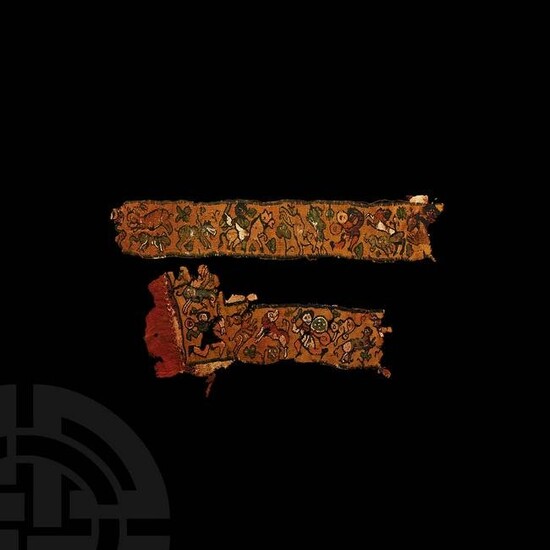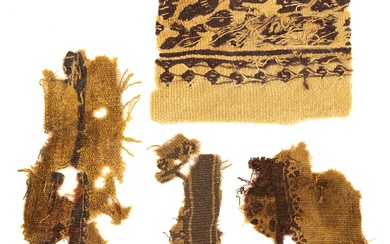Coptic Textile Fragment Group with Roman Soldiers
6th-7th century AD. A group of two tapestry fragments in silk and wool from a tunic or wall hanging, comprising: (i) a corner fragment of a tapestry showing two soldiers hunting, one with a cross traced as deigmaton on the round shield and a semi-spatha (sword) in his right hand, both dressed in Gothic tunics of green and off-white colour, black trousers and red sagia, escaping animals surrounding; (ii) a long segment (clavus) with a hunting scene comprising a cavalryman in green mantle, off-white tunic, shield and sword, a Nubian servant in exomis and holding a shield, chasing wild horses, antelopes, goats and hares, a third horseman half-visible on the right. Cf. Rutschowscaya, M., Coptic Fabrics, Paris, 1990, pp.41, 103-105, 117; Fluck, C., Vogelsang-Eastwood, Riding Costume in Egypt, origin and appearance, Leiden, Boston, 2004, figs.105 and esp. Col. fig.41. 8 grams total, 19-26cm (7 1/2 - 10 1/4"). Property of a Kensington gentleman; acquired from Hermann Historica, Germany, auction 67, part of lot 2025; accompanied by an archaeological report by Dr Raffaele D'Amato for which this is a part; this lot has been checked against the Interpol Database of stolen works of art and is accompanied by AIAD certificate number no.10681-174371(part"). Tabby technique on linen and wool. It is highly probable that this tapestry was part of a tunic decoration, the clavus (ii) running vertically on the breast; the corner fragment (i) forming the lower hem of the tunic. The representation of military characters, the red colour of the background, and the hunting parties – often associated with military training– indicate the likelihood that these are fragments from the military tunic of a high-ranking officer. [2]
Condition Report: Fair condition. Rare.
View it on
Estimate
Time, Location
Auction House
6th-7th century AD. A group of two tapestry fragments in silk and wool from a tunic or wall hanging, comprising: (i) a corner fragment of a tapestry showing two soldiers hunting, one with a cross traced as deigmaton on the round shield and a semi-spatha (sword) in his right hand, both dressed in Gothic tunics of green and off-white colour, black trousers and red sagia, escaping animals surrounding; (ii) a long segment (clavus) with a hunting scene comprising a cavalryman in green mantle, off-white tunic, shield and sword, a Nubian servant in exomis and holding a shield, chasing wild horses, antelopes, goats and hares, a third horseman half-visible on the right. Cf. Rutschowscaya, M., Coptic Fabrics, Paris, 1990, pp.41, 103-105, 117; Fluck, C., Vogelsang-Eastwood, Riding Costume in Egypt, origin and appearance, Leiden, Boston, 2004, figs.105 and esp. Col. fig.41. 8 grams total, 19-26cm (7 1/2 - 10 1/4"). Property of a Kensington gentleman; acquired from Hermann Historica, Germany, auction 67, part of lot 2025; accompanied by an archaeological report by Dr Raffaele D'Amato for which this is a part; this lot has been checked against the Interpol Database of stolen works of art and is accompanied by AIAD certificate number no.10681-174371(part"). Tabby technique on linen and wool. It is highly probable that this tapestry was part of a tunic decoration, the clavus (ii) running vertically on the breast; the corner fragment (i) forming the lower hem of the tunic. The representation of military characters, the red colour of the background, and the hunting parties – often associated with military training– indicate the likelihood that these are fragments from the military tunic of a high-ranking officer. [2]
Condition Report: Fair condition. Rare.




